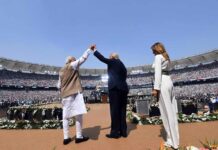Any major Project, Programs or Schemes are, at any point of time, a culmination of an evolutionary process, over a period of time across many teams, around the world. Steps taken, by and large, are a function of the ecosystem and compulsions of that time. Therefore, a simplistic rationale that the credit should go to the last person would be a travesty. If one insists on assigning credit to people, it would be reasonable to, at least, assess their value add contribution to the program.
GST has captured the imagination of the people as it not only eliminates the cascading effects of taxation, but also provides tax neutral impact for businesses at each stage of the product life cycle. Businesses get refunded for the taxes paid on inputs by them. Therefore, businesses do not mind paying taxes as they recover it from the refund. Hence, it is argued that the propensity to avoid taxes is low.
The ultimate objective of this exercise is to ensure that the price reductions are passed on to the ultimate consumer. For this to be effective, the underpinning requirement is computerization and speedy reimbursement of refunds.
GST was finally launched on July 1, 2016 with much fanfare. The Bhartiya Janata Party led by PM Modi projected it as a revolutionary event of the century. Its introduction was hyped as a second independence movement and was dramatized by celebrating it exactly along the lines of the historic midnight independence day event in the central hall of parliament.
The introduction of GST has been projected as a landmark revolutionary concept of the century. PM Modi & his party hyped it and claimed to have brought it to fruition that the Congress could not do for the last 70 years. It was repeatedly claimed that its success can be gauged from the taxpayer base increasing from around 80,000 dealers to over 1,30,000 in the first year or so. Sadly, the reality is that only top 50 tax assess account for over 67% of the tax revenues,
BJP has blasted the Congress of playing an obstructionist role in not allowing GST to be ushered in. The conspicuous absence of a credible counter narrative from congress and their inability to play the perception game well, did not help. All these perception games have certainly given advantage BJP and most people believe BJP has delivered the much needed GST. Analysis however reveals a different story.
Also Read: Bringing Businesses Back On Track, Govt Must Heed To Gadkari’s Advice
Worldwide, the real surge in VAT took place in the 1980s. The reality is that as far back as 1986, MODVAT Credit System was introduced and pilot automation efforts undertaken. In 1991, Chellaiah Committee was constituted to provide a road map and later Kelkar Committee, NIPF studies etc. outlined:
- Provide tax levy at each stage of the product/service life cycle and input tax credits at each stage to remove the cascading tax effect.
- Provide threshold of Rs 25 lakhs below which VAT should not be applicable
- Avoid Creeping exemptions
- Introduce self assessment system that will enable self policing and simplification of
processes.1996 introduction of self assessment was a defining moment in Indirect taxes. - Provide extensive training for enhancing tax administration skills & taxpayer education.
- Introduction of Computerization to enable IT based scrutiny and monitoring system.
- Create an environment of TRUST and confidence.
- Set up an independent ombudsman and early resolution of conflict management.
- Federal cooperation by Center compensating states for losses in the initial years.
In 1994, even Services were taxed and MODVAT extended to capital goods, a time when even European Unions had not implemented them. India was thus, ahead of the curve benchmark even internationally. Securing a Canadian collaboration, by 2000-01, a computerized Tax Audit System EA2000 was implemented. The system based scrutiny based on risk parameters not only reduced the inspection raj but enabled better quality audit. Total detections per audit increased to Rs.44.89 lakhs compared to Rs.1.48 lakhs under the old system.
Getting all the states on the same platform was a long drawn out challenging process which culminated in 1999 when the Chief Ministers and State ministers committed to the following decision:
- Introduction of State VATs with phase out of CST and abolition of Octroi& entry tax etc.
- Rate structures to be on four rates
- Traders with more than Rs.25,00,000 pa turnover to be included in state VAT
Why did they then not get implemented for years?
The reason for its slow adoption to implement appears to be primarily due to the level of computerization and lack of Internet penetration at that time. In fact,all the present GST issues were all addressed and resolved long back and nothing significantly new has been incorporated in the last few years to the concept.
Considerable efforts were needed to achieve “one common market” and build a strong Federal cooperative system. Empowered State Finance Minister Committee (which is now called the GST Council) was established to make collective decisions. The 13th and 14th Finance Commissions undertook independent studies and endorsed GST efforts. Studies and refinements took years as they do.
Pertinent to note that former Union finance minister P Chidambaram had first introduced the GST in his budget speech of 2006-07 and articulated a vision of launching GST by 2010.Significantly, legislative amendments to the constitution & legal issues had to be addressed. UPA-II government had tried hard to get the GST implemented but their efforts were stonewalled mainly due to fear of states loosing their autonomy.
The irony of the situation was that for years progress was stalled by objections mainly from the Bhartiya Janata Party and Mr. Modi in the avatar of Chief Minister of Gujarat in particular. They were GST’s most vocal and worst critic.
In early 2014, UPA government introduced the final bill by Mr. Chidambaram as the finance minister. However, the bill lapsed due to elections.
After assuming office in later half of 2014, the NDA Government re-tabled the final bill under a new bill number and it was only in 2016, that it got the parliamentary approval as opposition parties, including Congress, were already in support of the idea of ‘One Nation-One Tax, although differences of opinion over implementation remained.’
There is a deliberate perception created that the congress was stalling progress by being obscurantist. Congress only differed on four counts:
- There should be no levy of 1% by states in a destination-based tax. This was subsequently accepted.
- GST tax rates should not be beyond 18% especially because it was strongly endorsed by the Chief Economic Advisor who worked out the Revenue Neutral Rate (RNR) of 15-15.5%. Further, it was in line with international practices. Congress argued that since over 70% of the goods were taxed around 13% there cannot be any justification for not having an upper limit of 18%. This was not agreed by BJP and stuck to higher rates. Over the last 18 months or so, due to low compliance issues and a shortfall of over 80,000 crores, the GST rates are being brought down.
- Need for setting up an Authority under the constitution for dispute resolution. This point again has been based on the past experiences as well as the newly felt need. It is a matter of time that this will be done.
- Some drafting language issues.These were corrected.
Despite being reasonable objections, the utter lack of Congress’s ability to manage perceptions has resulted in their being perceived as preventing earlier implementation of GST.
So, for giving credit by what yardstick should the contribution of BJP be measured? Since conceptual framework, legislative amendments, administrative structures etc. and schemes can be traced back to 1990s, the effective contribution yardstick should be the effective implementation of GST.
Viewed on this count, sufficient evidence is available to conclude that BJP government failed miserably on this score. Despite serious objections by a number of state ministers at the GST council and repeated pleas by the GSTN about the platform not being ready, advice by the bureaucracy to delay implementation etc. government insisted on launch of July 1, 2016, if only, to prove that they were better at Governance. BJP brought it upon itself, by needless narrative, to establish that they were superior in Governance and hence have been able to implement in a short time, what congress could not do for decades.
Result, the portal collapsed on the first day itself; Policies and processes were evolving on a frequent basis creating serious problems of “catch up”.The number of fraud cases increased by 400% from Rs.9.75 crores in 2018-2018 to Rs.3,700 Crores in 2018-2019.
Training of all the stakeholders were insufficient causing confusion fear, anger among all stakeholders. The government had to suspend a number of its operations resulting in huge revenue losses.
Over the last 18 months, the collections fell far short of the targets and revised targets by over Rs.1,00,000 crores. In short, BJP governance fell flat on this score, learning’s notwithstanding. Estimates indicate that despite tax rates being lowered to the extent of Rs. 50,000 crores, it was not passed on to the consumers as planned.
To conclude, it is essential for the true facts to overshadow the marketing efforts by anyone or any single party so that the sanctity of facts does not get distorted. Everyone can have their opinions, biases and fancies but, for a strong democracy, facts should not be misrepresented or distorted. Perceptions are more important than truth!!!
Disclaimer: The information, ideas or opinions appearing in this article are those of the author and do not necessarily reflect the views of N4M Media.























The article traces the evolution of GST in an honest and balanced way. It carries an important message that any major reform involves many people and parties over years. Credit cannot be taken only by the party that implements it. I agree with the author that BJP has stolen the thunder from Congress though the latter has contributed significantly to the GST thinking and policies.
Very well written article